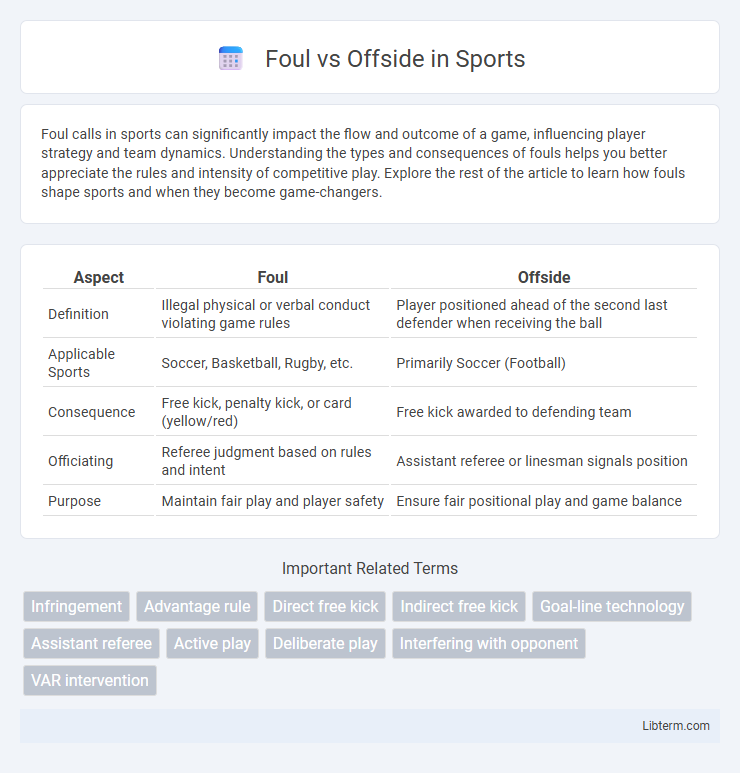Foul calls in sports can significantly impact the flow and outcome of a game, influencing player strategy and team dynamics. Understanding the types and consequences of fouls helps you better appreciate the rules and intensity of competitive play. Explore the rest of the article to learn how fouls shape sports and when they become game-changers.
Table of Comparison
| Aspect | Foul | Offside |
|---|---|---|
| Definition | Illegal physical or verbal conduct violating game rules | Player positioned ahead of the second last defender when receiving the ball |
| Applicable Sports | Soccer, Basketball, Rugby, etc. | Primarily Soccer (Football) |
| Consequence | Free kick, penalty kick, or card (yellow/red) | Free kick awarded to defending team |
| Officiating | Referee judgment based on rules and intent | Assistant referee or linesman signals position |
| Purpose | Maintain fair play and player safety | Ensure fair positional play and game balance |
Introduction: Understanding Foul and Offside
Foul and offside are fundamental rules in soccer that regulate fair play and game flow. A foul occurs when a player commits an unfair or dangerous action against an opponent, such as tripping or pushing, resulting in a free kick or penalty. Offside is an infringement that happens when an attacking player is positioned closer to the opponent's goal line than both the ball and the second-last defender at the moment the ball is played to them, leading to a stoppage and a free kick for the defending team.
Definition of Foul in Football
A foul in football occurs when a player violates the rules by unfairly challenging an opponent, such as by tripping, pushing, or handling the ball deliberately. It results in a free kick or penalty kick awarded to the opposing team, depending on the location of the infringement. Fouls are distinct from offside offenses, which involve positional infractions rather than illegal physical contact or rule breaches.
Definition of Offside in Football
Offside in football occurs when an attacking player is positioned nearer to the opponent's goal line than both the ball and the second-last defender at the moment the ball is played to them, provided they are involved in active play. The offside rule aims to prevent players from gaining unfair advantage by "goal-hanging" near the opponent's goal. Referees enforce this rule to maintain fair play and ensure the attacking team doesn't exploit positional advantages.
Key Differences Between Foul and Offside
Foul and offside are two distinct types of violations in soccer with different implications and rules. A foul occurs when a player commits unfair physical contact, such as tripping or pushing, resulting in a free kick or penalty. Offside is a positional offense where a player is nearer to the opponent's goal line than both the ball and the second-last defender at the moment the ball is passed, leading to an indirect free kick for the opposing team.
Common Types of Fouls
Common types of fouls in football include tripping, pushing, holding, and charging an opponent unfairly. These actions violate the rules by impeding an opponent's movement or gaining an unfair advantage, resulting in free kicks or penalty kicks. Offside, in contrast, is a positional violation occurring when an attacking player is nearer to the opponent's goal line than both the ball and the second-last defender at the moment the ball is played to them.
How the Offside Rule Works
The offside rule in soccer is designed to prevent players from gaining an unfair advantage by staying closer to the opponent's goal line than both the ball and the second-last defender at the moment the ball is played to them. A player is considered offside if they are in the opponent's half, involved in active play, and positioned beyond the second-last defender when a teammate passes the ball. Referees use this rule to maintain fair play and ensure strategic positioning rather than physical fouls dictate game flow.
Referee Signals for Foul vs Offside
Referee signals for fouls typically involve extending the arm forward while blowing the whistle to indicate an infringement such as tripping, pushing, or holding. In contrast, for an offside offense, the referee raises the flag vertically above the head to signal the assistant referee, who then confirms the offside position before play is stopped. Clear and distinct signaling ensures players and spectators understand the nature of the rule violation, facilitating fair and efficient game management.
Impact of Fouls and Offside on Gameplay
Fouls disrupt the flow of gameplay by awarding free kicks or penalties, often shifting momentum and creating scoring opportunities for the opposing team. Offside decisions halt attacking plays, preventing unfair advantages and maintaining defensive balance, which influences team strategies and pacing. Both fouls and offside rulings significantly impact match dynamics, player behavior, and overall tactical execution on the field.
Controversial Moments: Foul or Offside?
Controversial moments in football often arise when it's unclear whether a foul or offside has occurred, requiring precise referee judgment and advanced video technology like VAR for accurate decisions. Fouls involve illegal physical contact or unfair play, while offside pertains to a player's position relative to the last defender when receiving the ball. These incidents frequently ignite debate due to their significant impact on match outcomes and the interpretation of complex, fast-paced situations.
Conclusion: Importance of Knowing the Rules
Understanding the distinct rules of foul and offside in soccer is crucial for players, referees, and enthusiasts to ensure fair play and accurate game decisions. Mastery of these regulations prevents unnecessary penalties and maintains the flow of the match while upholding the sport's integrity. Clear knowledge of foul and offside rules contributes significantly to strategic gameplay and effective officiating.
Foul Infographic

 libterm.com
libterm.com